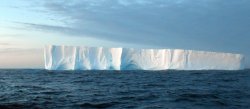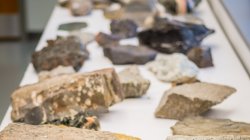Traveling through Iceberg Alley
Associate Dean Dr. Stefanie Brachfeld is conducting research in the Antarctic on the Joides Resolution.
Posted in: Department Research, Faculty

The current expedition, Iceberg Alley and Subantarctic Ice and Ocean Dynamics, is looking at the dust, dirt, and rocks carried by icebergs, known as “iceberg rafted debris.” This debris falls to the seafloor as icebergs melt in warmer waters, and is deposited as sediment. The JOIDES Resolution can drill hundreds of meters into this sediment and retrieve long cylinders of mud called cores. These sediment cores will provide a nearly continuous history of changes in melting of the Antarctic Ice Sheet.
Analyzing the iceberg rafted debris can tell us when the ice sheet calved icebergs and even which part of Antarctica they came from. At times when more debris was deposited, we know the ice sheet was less stable. Much shorter cores previously collected at our drilling sites reveal high sedimentation rates, allowing us to observe climatic and ice sheet changes on timescales ranging from just tens to hundreds of years.
Scientists have discovered that episodes of massive iceberg discharge can happen abruptly, within decades. This has huge implications for how the Antarctic Ice Sheet may behave in the future.
We will also explore how ocean currents, sea ice, and atmospheric conditions in the past are related to changes in melting of the Antarctic Ice Sheet. As we collect cores to the north and the south of the Drake Passage, the narrow waters between Antarctica and the tip of South America, we will be able to see how the Antarctic Circumpolar Current has changed over time. Our northern drilling sites will additionally tell us about another historically important ice sheet: the Patagonia Ice Sheet.
Together, all of this data will illustrate the long-term climate history of Antarctica, showing how the ice sheets responded to changes in atmospheric carbon dioxide in the past, and how changes in the ice sheet influenced global sea level. This knowledge will help us understand how the Antarctic Ice Sheet may respond in a warming world, better preparing us for future global sea level rise.
Keep up to date with Dr. Brachfeld and the expedition on the Joides Resolution website and blog.
